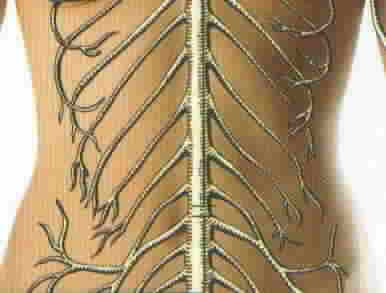BODY WALL

Ancient body part. 1. Nonverbally, an expressive unit consisting of the head and trunk (without the face, shoulders, arms, hands, legs, or feet). 2. Those muscles connecting the skull, spine, and ribs. 3. The "primal body," resembling the primordial feeding tube, from which the human form evolved ca. 500 m.y.a.
Usage: Movements and postures of the body wall (see, e.g.,
BODY-BEND, BODY-SHIFT, and BOW) are
a. more basic, b. more trustworthy as
cues, and c. less subject to conscious
manipulation or control than are other body movements (e.g., of the fingers,
hands, legs, and feet) and postures. The muscles, nerves, and movements of the
body wall resemble those of the first vertebrates ever to swim in Nonverbal
World, the jawless fishes (see AQUATIC BRAIN & SPINAL CORD).
Anatomy. On the basis of
function (rather than mere convention), anatomists divide the human skeleton
into primary and secondary elements (Horne 1995). The basic
distinction between an axial (i.e., skull, spine, and ribs) and
appendicular (i.e., pectoral and pelvic girdles, and limbs) skeleton is
reflected in our nonverbal communication, as well. As expressive cues, movements
of the body wall are more fundamental as mood signs than are our hand, arm, and
leg motions.
Evolution. Before faces and limbs, there was the body wall. Its skeletal muscles were designed to move the body from one place to another. Sinuous waves of contraction bent the body wall, producing the swimming motions that took animals a. toward food and mates, and b. away from enemies. Undulations moved from the head to the tail, and laterally from side-to-side. (N.B.: The ancient body wall bent the backbone forward [ventral flexion], and backward [dorsal flexion] as well [Kent 1969].)
Observation. In a business meeting (where feelings run high), the most truthful gestures come not from the limbs but from the torso. Isolating on unconscious locomotion movements (i.e., on sideward, forward, and backward bending motions), as bodies unwittingly align, approach, avoid, or repel one another, reveals where colleagues truly "stand" around the conference table. From the jawless fishes of Ordovician seas to the predatory sharks of Wall Street, messages of the body wall are much the same.
RESEARCH REPORTS. 1. Epaxial muscles, which extend from the base of the head to the tip of the tail, dorsal to the transverse processes, include the longissimus, iliocostalis, and transversospinalis groups, and the intervertebral muscles. "Epaxial muscles in tetrapods perform the same primary function as in fishes--side-to-side and dorsoventral flexion of the vertebral column" (Kent 1969:218). (Epaxial muscles also help to move the head.) 2. Regarding hypaxial muscles: ". . . in the majority of tetrapods the muscles of the body wall are used chiefly to compress the viscera and to operate the ribs for respiration" (Kent 1969:220).
See also PALEOCIRCUIT.
YouTube Video: Watch a two-minute video showing the muscles of the body wall.Copyright 1999 - 2016 (David B.
Givens/Center for Nonverbal Studies)
Detail of illustration of segmented nerves of the primal body wall (copyright 2004 by DK Publishing, Inc.)